Mental health in the workplace has become a more prevalent part of the conversation, yet is still seen as something of a taboo subject for many.
Research conducted by Businessolver found that 68% of employees were worried that reaching out for help with a mental health issue could impact their job security.
Oak Engage’s Mental Health in the Workplace Report in partnership with If U Care Share, found that 58% of all employees have suffered physical or mental stress in the previous 18 months as a result of work. Directly or indirectly, most of us are impacted by mental health issues at work, something that has intensified in recent times.
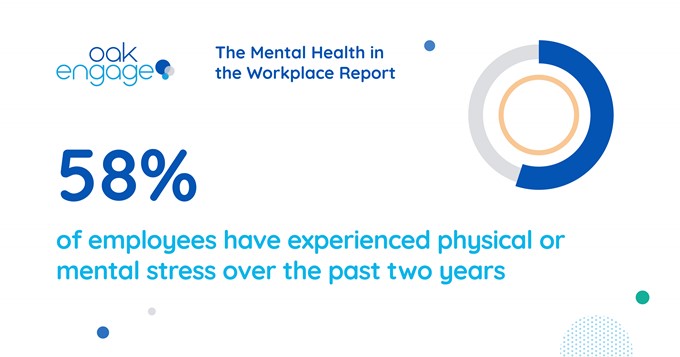
In this blog we will explore some of the common drivers of mental health issues and how to combat them, based on our research.
Why is mental health in the workplace important?
We spend a majority of their time at work, the average person will spend around 90,000 hours at work; that’s one-third of a lifetime. If we are unhappy at work it will ultimately spill over into our lives.
From a business perspective, cultures where poor mental health is more common will experience higher employee turnover, lower productivity and reputational damage.
Mental Health in the Workplace statistics
Our Mental Health in the Workplace Report surveyed employees across 9 different industries to delve into some of the issues . Let’s take a look at a few of the key findings:
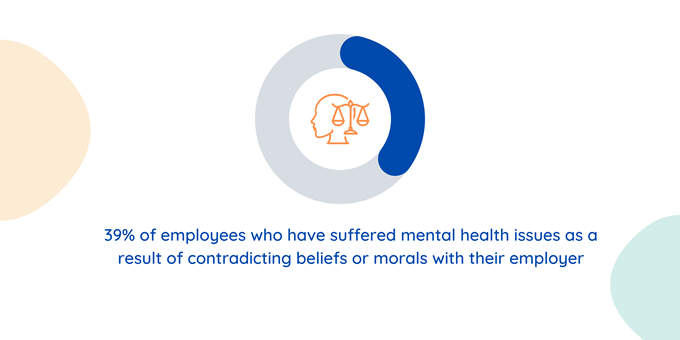
Most workers will have seen their organisation conducting themselves in a way that doesn’t sit well with them. However, if a business consistently acts unethically or is not fully transparent when mistakes are made, it will make employees uneasy. 39% of employees who suffered mental health issues at work did so because of the organisation contradicting their own morals.
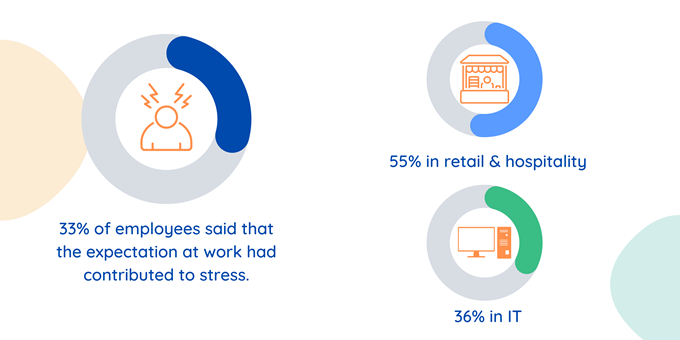
Expectation can weigh heavily on the shoulders of employees, particularly when targets are unrealistic. A third of employees who had suffered mental health issues at work said that expectation in their role had been a contributing factor. This was highest in retail & hospitality at 55%.
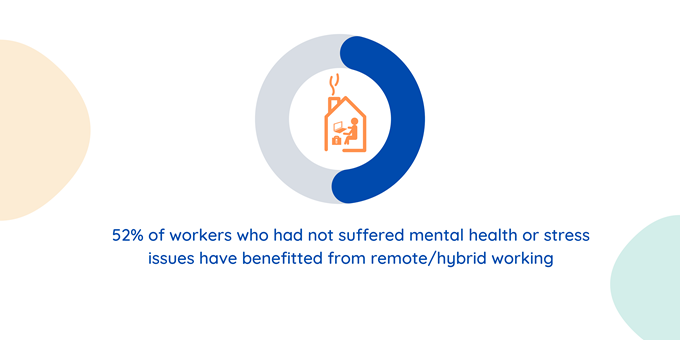
A lot has been made of the links between remote working and isolation or a lack of storing working relationships. However, the report found that 52% of employees who had not suffered from mental health issues in fact benefited from remote or hybrid working.
Common mental health issues at work
Click on one of the common mental health issue to reveal a practical tip...
There are some common characteristics of poor mental health issues, which can be difficult to spot:
Stress
Stress has a severe impact on a person's well being. Work-related stress can have both mental and physical effects.
Mental effects include:
- Feeling that you can’t cope with your workload
- Lack of motivation and job satisfaction
- Feeling irritable and increased mood swings
- Not feeling good enough
Physical effects include:
- Feeling tired and having little energy
- Stomach aches
- Headaches
- Changes in weight
Stress is the single biggest cause of sick leave in the UK. Not only will you lose output from the absentee, other workers will have to pick up the slack which will cause more stress throughout the workforce.
If you suspect an employee might be dealing with stress you should take action immediately to prevent the issue spreading. Establish the root cause of the stress by talking to your employee on a one to one level. There could be a number of reasons why your employee is feeling stressed, such as heavy workload, long working hours or conflicts with colleagues.
Think about the changes you could make in the workplace to relieve the stress on the employee. For example, if they are dealing with a heavy workload you could slim down your workflow process or implement a document management system where employees can keep track of their workload.
Anxiety
Anxiety presents itself in similar ways to stress and is very common in the workplace. If you suspect someone in your workplace might be dealing with anxiety, make sure you tackle the problem as soon as possible.
Symptoms of workplace anxiety include:
- Trouble sleeping
- Excessive worrying
- Self-doubt
- Bad memory
- Loss of interest in work
- Irrational fear of making a mistake
Employees may be anxious about their performance, interactions with colleagues or anything work related that makes them uncomfortable. Being able to speak up about these issues and getting reassurance can help to ease anxiety. Regular 1:1s between management and employee and safe spaces to chat to colleagues can help people realise they are not alone.
Burnout
The main cause of employee burnout is a heavy workload but other factors can contribute to burnout such as unclear job expectations, poor work/life balance and dysfunctional working dynamics. Employee burnout can be incredibly dangerous to an employee as it reduces productivity, affects energy levels and can severely harm mental health.
If you think an employee might be suffering from burnout these are the signs to look out for:
- Loss of motivation
- Detachment from work
- A cynical and negative outlook
- Withdrawing from responsibilities
The Mental Health in the Workplace Report found that 19% of mental health issues stem from burnout, as high as 33% in the public sector. It is something that needs to be addressed as part of any wellbeing strategy.
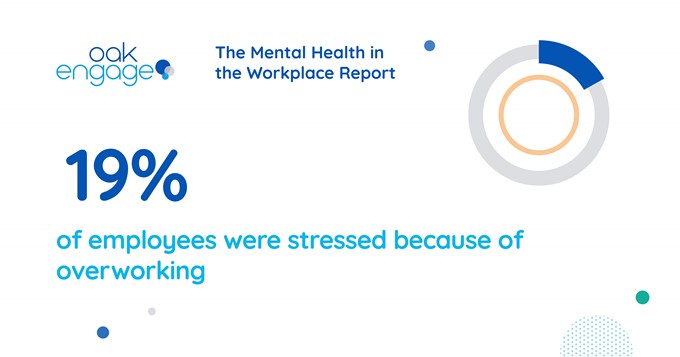
“The pandemic has underscored the importance of work-life balance and what that does for wellbeing and stress reduction. Every company should have a stress management strategy and regular employee training if they want to prevent employees from burning out.”
Joe Robinson, CEO of WorktoLive
Depression
Although the symptoms may cross over, workplace stress is very different to workplace depression. Depression is the most common mental health problem in the UK, affecting 4-10% of people in the UK.
Much like the other factors that affect mental health, depression can be a result of long working hours, conflict in the workplace, poor work/life balance and increased pressure from management. People suffering from depression usually find it difficult to express their feelings.
Depression can also be the build up of factors inside and outside of work. This is why it is so important to create a culture of transparency and where employees can feel like they can speak about their problems.
How to talk about mental health in the workplace
To remove the stigma surrounding mental health at work, you should encourage conversations between employees to normalise the topic.
To help employees feel comfortable about discussing mental health make sure you operate an open-door policy. This means a manager's door (physical or virtual) must be open to every employee to encourage communication and facilitate feedback.
However, some employees may not be comfortable speaking to a manager or colleague. In this instance, anonymised feedback can also be a good way to inform wellbeing policy. With Oak Engage’s Pulse Surveys, the integrated analytics dashboard allows you to view real-time insights and make informed decisions on the back of the data.
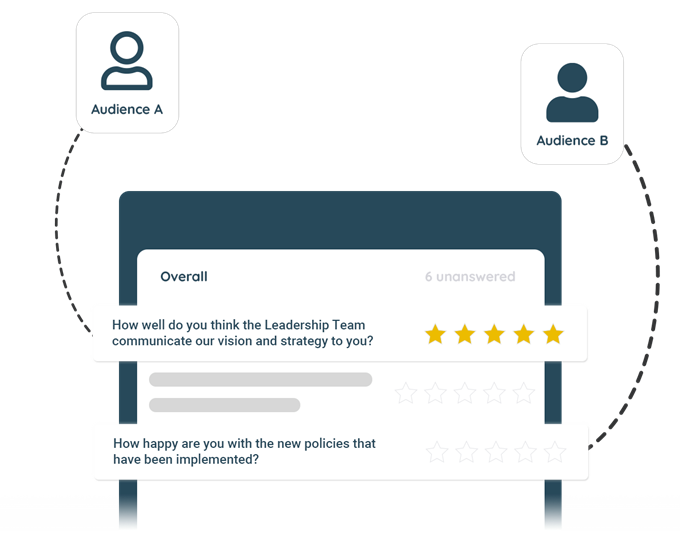
How to improve workplace mental health
Workplace mental health should always be approached with caution. As we discussed earlier, there are different ways poor mental health can present itself and it’s important to tackle these appropriately. It's important to bear in mind the breath of mental illnesses. A measured approach should be taken int account, bearing in mind the overall diversity of mental health.
It all starts with open, honest conversations. How you enable this and you get the information will depend on your workforce, but regardless it starts with leadership.
‘With communication that connects leadership to the workforce you help to build more of a community spirit within the organisation. An open door policy with a direct link to everyone in the business is one way to achieve this.’
Oak Engage's Mental Health in the Workplace Report
In virtual workplaces or those with offices across different locations, an employee directory can serve as the bridge between employees that may be hard to reach. The ability for employees to find contact details for HR, wellbeing champions or managers could be invaluable.
How employees feel about the organisation will also contribute to their mental health, particularly if they feel like their morals are being compromised. This is why your brand vision and messaging need to be clear, but also that the messaging is engaging to the individual. Through curated content streams, content can be sent to the right people, at the right time on the right device to ensure optimum engagement.
Whilst mental health in the workplace is not an easy subject to broach, the issues and recommendations highlighted in this blog will stand you in good stead.
Download your copy of the Mental Health in the Workplace for more insights.



